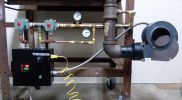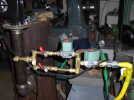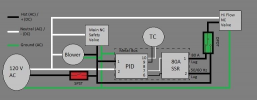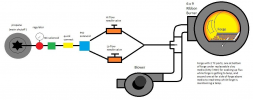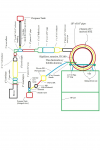-
The BladeForums.com 2024 Traditional Knife is ready to order! See this thread for details: https://www.bladeforums.com/threads/bladeforums-2024-traditional-knife.2003187/
Price is$300$250 ea (shipped within CONUS). If you live outside the US, I will contact you after your order for extra shipping charges.
Order here: https://www.bladeforums.com/help/2024-traditional/ - Order as many as you like, we have plenty.
You are using an out of date browser. It may not display this or other websites correctly.
You should upgrade or use an alternative browser.
You should upgrade or use an alternative browser.
Temperature control for the forge
- Thread starter Gosolo
- Start date
Stacy E. Apelt - Bladesmith
ilmarinen - MODERATOR
Moderator
Knifemaker / Craftsman / Service Provider
- Joined
- Aug 20, 2004
- Messages
- 37,854
The valve isn't actually controlled. It is the burner that gets adjusted.
Here is a brief overview I posted:
Read the Two-Stage PID Controlled Forge sticky. The process is very simple, ant does not need proportional control. The whole setup can be made for around $100.
You need a:
PID - Any inexpensive PID controller will do. It only need SSR output contacts for our use (all of them have this).
SSR - A Solid State Relay ...SSR ... turns the solenoid ( or any load device) on and off. 40 amps is a good size. Even though the solenoid will draw a very low current, the 40 amp SSR will not need a heat sink. If the SSR has a built in heat sink, so much the better.
Solenoid - You want a 120VAC on/off gas solenoid valve that is rated for propane/natural gas. It should be rated to 15PSI. 1/4" ports are the best size.
Needle valves - two simple 1/4" needle valves, some elbows/tees/pipe/hose/etc.
Thermocouple - Type K thermocouple, 8 to 10 gauge (1/8") size is what you want. You want one with the round spacers to keep the leads apart. Thermocouples are polarized, they must be wire correctly.
TC sheath - For a forge, you need to protect the TC from the flame. A ceramic TC sheath that fits the TC with the sacers on it is usually a 3/4" sheath.
TC block - A TC mounting block is the best way to connect the 1/8" TC leads to the 20 gauge wires going to the PID.
TC wires - You need type K wires to connect the PID to the TC. The wires ar polarized and balanced to make the reading accurate. 20 gauge is a good size.
Here is a wonderful build tutorial:
 www.bladeforums.com
www.bladeforums.com
Another thread on making one:
 www.bladeforums.com
www.bladeforums.com
Here is a brief overview I posted:
Read the Two-Stage PID Controlled Forge sticky. The process is very simple, ant does not need proportional control. The whole setup can be made for around $100.
You need a:
PID - Any inexpensive PID controller will do. It only need SSR output contacts for our use (all of them have this).
SSR - A Solid State Relay ...SSR ... turns the solenoid ( or any load device) on and off. 40 amps is a good size. Even though the solenoid will draw a very low current, the 40 amp SSR will not need a heat sink. If the SSR has a built in heat sink, so much the better.
Solenoid - You want a 120VAC on/off gas solenoid valve that is rated for propane/natural gas. It should be rated to 15PSI. 1/4" ports are the best size.
Needle valves - two simple 1/4" needle valves, some elbows/tees/pipe/hose/etc.
Thermocouple - Type K thermocouple, 8 to 10 gauge (1/8") size is what you want. You want one with the round spacers to keep the leads apart. Thermocouples are polarized, they must be wire correctly.
TC sheath - For a forge, you need to protect the TC from the flame. A ceramic TC sheath that fits the TC with the sacers on it is usually a 3/4" sheath.
TC block - A TC mounting block is the best way to connect the 1/8" TC leads to the 20 gauge wires going to the PID.
TC wires - You need type K wires to connect the PID to the TC. The wires ar polarized and balanced to make the reading accurate. 20 gauge is a good size.
Here is a wonderful build tutorial:
PID Controlled Forge/Heat Treat oven plans & WIP
So after going through the stickys a couple weeks ago and finding all of the amazing plans for different PID controlled forges, tempering ovens, salt pot etc, I've switched gears fully to creating a really high-functioning PID controlled forge & heat treating oven. First off, thanks to other...
 www.bladeforums.com
www.bladeforums.com
Another thread on making one:
Forge Build Tips Before I Build One
I'm about ready to start building a forge. I want to do it right from the start so I don't have to redo anything in the future and I want it to last. I've been reading through all the stickys and think I have most of it figured out, but some of the pictures and diagrams are missing now. I have...
 www.bladeforums.com
www.bladeforums.com
Last edited:
Stacy, thank you for the help and links. There’s plenty to read here and I think it’s going to get read several times.The valve isn't actually controlled. It is the burner that gets adjusted.
Here is a brief overview I posted:
Read the Two-Stage PID Controlled Forge sticky. The process is very simple, ant does not need proportional control. The whole setup can be made for around $100.
You need a:
PID - Any inexpensive PID controller will do. It only need SSR output contacts for our use (all of them have this).
SSR - A Solid State Relay ...SSR ... turns the solenoid ( or any load device) on and off. 40 amps is a good size. Even though the solenoid will draw a very low current, the 40 amp SSR will not need a heat sink. If the SSR has a built-in heat sink, so much the better.
Solenoid - You want a 120VAC on/off gas solenoid valve that is rated for propane/natural gas. It should be rated to 15PSI. 1/4" ports are the best size.
Needle valves - two simple 1/4" needle valves, some elbows/tees/pipe/hose/etc.
Thermocouple - Type K thermocouple, 8 to 10 gauge (1/8") size is what you want. You want one with the round spacers to keep the leads apart. Thermocouples are polarized, they must be wire correctly.
TC sheath - For a forge, you need to protect the TC from the flame. A ceramic TC sheath that fits the TC with the sacers on it is usually a 3/4" sheath.
TC block - A TC mounting block is the best way to connect the 1/8" TC leads to the 20 gauge wires going to the PID.
TC wires - You need type K wires to connect the PID to the TC. The wires ar polarized and balanced to make the reading accurate. 20 gauge is a good size.
Here is a wonderful build tutorial:
PID Controlled Forge/Heat Treat oven plans & WIP
So after going through the stickys a couple weeks ago and finding all of the amazing plans for different PID controlled forges, tempering ovens, salt pot etc, I've switched gears fully to creating a really high-functioning PID controlled forge & heat treating oven. First off, thanks to other...www.bladeforums.com
Another thread on making one:
Forge Build Tips Before I Build One
I'm about ready to start building a forge. I want to do it right from the start so I don't have to redo anything in the future and I want it to last. I've been reading through all the stickys and think I have most of it figured out, but some of the pictures and diagrams are missing now. I have...www.bladeforums.com
Last edited by a moderator:
Stacy E. Apelt - Bladesmith
ilmarinen - MODERATOR
Moderator
Knifemaker / Craftsman / Service Provider
- Joined
- Aug 20, 2004
- Messages
- 37,854
- Joined
- Jul 3, 2022
- Messages
- 145
I run a selonoid on the bypass only, with a ribbon burner. I have a 15f swing @ 15 seconds. I also have a simple 1 pole switch to interrupt the PID if I want a tighter swing, You can tighten up with calibrating the rate of correction; But, you can burn your valve up when it is firing too fast.
Stacy E. Apelt - Bladesmith
ilmarinen - MODERATOR
Moderator
Knifemaker / Craftsman / Service Provider
- Joined
- Aug 20, 2004
- Messages
- 37,854
Yes, the last drawing is misleading. The control (PID) solenoid is in the high flow (bypass) side.
- Joined
- Jul 3, 2022
- Messages
- 145
I like the design that you posted with the additional valve, I like having the gas off w/ power loss.
I tolerate one because what I do in the forge requires me to be at the forge.
I tolerate one because what I do in the forge requires me to be at the forge.
Stacy E. Apelt - Bladesmith
ilmarinen - MODERATOR
Moderator
Knifemaker / Craftsman / Service Provider
- Joined
- Aug 20, 2004
- Messages
- 37,854
There are other uses for this two-stage control in a forge.
Instead of a PID to control the forge burner, you can use an foot pedal. Step on the pedal and the forge shifts to high flame. Step on it again and it goes to a low flame idle. This works well to save gas during forging sessions. The type pedal switch you want is a "maintained switch". Step once and it is ON , step again and it is OFF. You can easily add the pedal as a second control source and put a DPDT switch to switch the forge from PID to PEDAL for both forging as well as HT. The switch would be placed in the DC control lines to the SSR. There are other configurations possible as well.
These pedal switches are used to control machines and lights by foots. Using one to control an SSR allows it to run most any device. I use them to turn on and off machines like the grinders, drill press, and band saw so I have both hands on the work all the time. On some machines, like saws, I use a momentary contact foot pedal. That way if I take my foot off, the machine stops instantly.
There are two types. The heavier duty ones usually control 15amps. They have a plug that the device plugs into and the pedal starts and stops the device. These are good for 115V tools.
The other type is much cheaper and is just an On=OFF footswitch that you wire yourself. These are rated a couple amps and work well with an SSR. You just need a DC power source. Any old charge transformer will work for that.
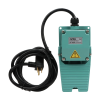
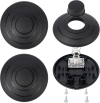
Instead of a PID to control the forge burner, you can use an foot pedal. Step on the pedal and the forge shifts to high flame. Step on it again and it goes to a low flame idle. This works well to save gas during forging sessions. The type pedal switch you want is a "maintained switch". Step once and it is ON , step again and it is OFF. You can easily add the pedal as a second control source and put a DPDT switch to switch the forge from PID to PEDAL for both forging as well as HT. The switch would be placed in the DC control lines to the SSR. There are other configurations possible as well.
These pedal switches are used to control machines and lights by foots. Using one to control an SSR allows it to run most any device. I use them to turn on and off machines like the grinders, drill press, and band saw so I have both hands on the work all the time. On some machines, like saws, I use a momentary contact foot pedal. That way if I take my foot off, the machine stops instantly.
There are two types. The heavier duty ones usually control 15amps. They have a plug that the device plugs into and the pedal starts and stops the device. These are good for 115V tools.
The other type is much cheaper and is just an On=OFF footswitch that you wire yourself. These are rated a couple amps and work well with an SSR. You just need a DC power source. Any old charge transformer will work for that.



